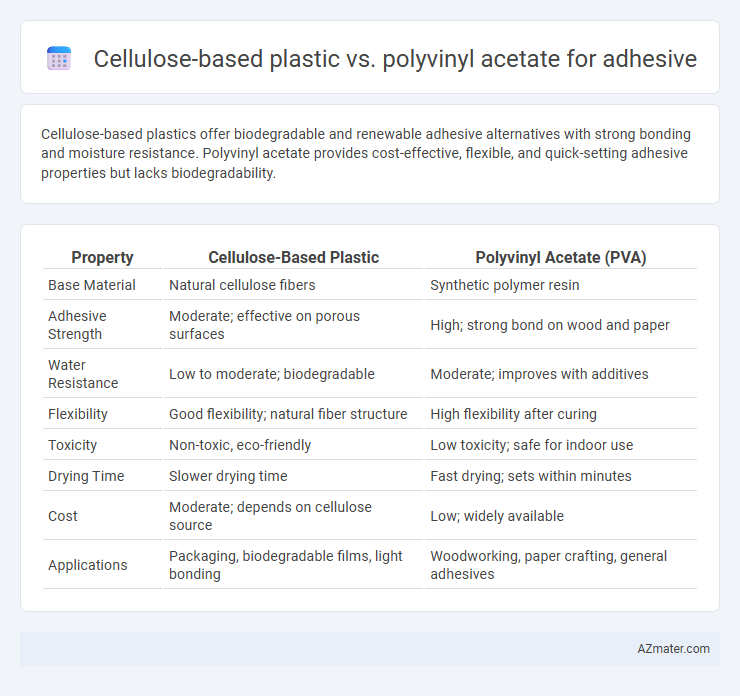Cellulose-based plastics offer biodegradable and renewable adhesive alternatives with strong bonding and moisture resistance. Polyvinyl acetate provides cost-effective, flexible, and quick-setting adhesive properties but lacks biodegradability.
Table of Comparison
| Property | Cellulose-Based Plastic | Polyvinyl Acetate (PVA) |
|---|---|---|
| Base Material | Natural cellulose fibers | Synthetic polymer resin |
| Adhesive Strength | Moderate; effective on porous surfaces | High; strong bond on wood and paper |
| Water Resistance | Low to moderate; biodegradable | Moderate; improves with additives |
| Flexibility | Good flexibility; natural fiber structure | High flexibility after curing |
| Toxicity | Non-toxic, eco-friendly | Low toxicity; safe for indoor use |
| Drying Time | Slower drying time | Fast drying; sets within minutes |
| Cost | Moderate; depends on cellulose source | Low; widely available |
| Applications | Packaging, biodegradable films, light bonding | Woodworking, paper crafting, general adhesives |
Introduction to Adhesive Materials
Cellulose-based plastic adhesives offer biodegradability and eco-friendly properties, making them suitable for sustainable bonding applications. Polyvinyl acetate (PVA) adhesives provide strong adhesion, fast drying times, and excellent compatibility with porous materials like wood and paper. Both materials are widely used in industries requiring durable, versatile, and cost-effective adhesive solutions.
Overview of Cellulose-Based Plastics
Cellulose-based plastics, derived from natural cellulose fibers, offer eco-friendly and biodegradable alternatives to traditional adhesives like polyvinyl acetate (PVA). These bioplastics exhibit strong adhesion properties, high tensile strength, and resistance to grease and oils, making them suitable for applications requiring sustainability and environmental safety. Their renewable origin and lower environmental impact position cellulose-based plastics as a promising choice for green adhesive technologies.
Understanding Polyvinyl Acetate (PVA)
Polyvinyl acetate (PVA) is a widely used synthetic polymer in adhesives known for its strong bonding properties, flexibility, and quick drying time, making it ideal for woodworking, paper, and fabric applications. Compared to cellulose-based plastics, PVA adhesives offer superior water resistance and durability but may lack biodegradability, which cellulose alternatives provide due to their renewable plant-based origins. Understanding PVA's chemical structure reveals its ester functional groups that contribute to its cohesive strength and ease of formulation into various adhesive products.
Chemical Structure Comparison
Cellulose-based plastics are composed of long chains of glucose units linked by b(1-4) glycosidic bonds, providing rigidity and biodegradability, while polyvinyl acetate (PVA) consists of vinyl acetate monomers polymerized into a synthetic acetate polymer with ester functional groups. The hydroxyl groups in cellulose facilitate hydrogen bonding, enhancing adhesion to natural fibers, whereas PVA's acetate groups influence flexibility and water resistance in adhesives. Chemical structure differences dictate performance characteristics, with cellulose-based adhesives favoring eco-friendly applications and PVA offering versatile bonding with diverse substrates.
Adhesive Properties: Cellulose-Based vs. PVA
Cellulose-based plastic adhesives exhibit excellent biodegradability and strong fiber-to-fiber bonding, making them ideal for wood and paper applications due to their natural compatibility and moisture resistance. Polyvinyl acetate (PVA) adhesives offer superior tackiness, faster drying times, and higher initial bond strength on porous substrates, commonly used in woodworking and packaging industries. While cellulose-based adhesives provide environmental benefits and durable bonding in humid conditions, PVA adhesives excel in quick curing and versatile adherence to a variety of materials.
Environmental Impact and Biodegradability
Cellulose-based plastics offer superior environmental benefits due to their biodegradability and origin from renewable resources like wood pulp, reducing reliance on fossil fuels and minimizing plastic waste accumulation. Polyvinyl acetate (PVA), a synthetic polymer commonly used in adhesives, is less biodegradable and derived from petrochemicals, contributing to longer environmental persistence and higher carbon footprints. The eco-friendly nature of cellulose-based adhesives supports sustainable waste management and decreases overall ecological impact compared to PVA-based counterparts.
Performance in Industrial and Household Applications
Cellulose-based plastic adhesives offer superior biodegradability and resistance to heat and moisture, making them ideal for environmentally conscious industrial applications requiring durability and safety. Polyvinyl acetate (PVA) adhesives excel in quick bonding, flexibility, and strong adhesion on porous surfaces, widely favored for household repairs and woodworking due to ease of use and cost-effectiveness. Industrial use favors cellulose-based adhesives for sustainability and chemical resistance, while PVA remains preferred in domestic settings for versatility and fast curing times.
Cost and Availability Analysis
Cellulose-based plastic adhesives generally offer a cost-effective solution due to their renewable raw materials and lower production expenses compared to synthetic polymers. Polyvinyl acetate (PVA), although slightly more expensive, provides widespread availability driven by extensive industrial-scale manufacturing and consistent supply chains. The choice between them often hinges on balancing budget constraints with the need for readily accessible adhesive materials in various market sectors.
Safety and Health Considerations
Cellulose-based plastics offer superior safety profiles due to their biodegradability and lower toxic emissions, reducing environmental and health risks compared to polyvinyl acetate (PVA) adhesives, which may release volatile organic compounds (VOCs) during curing. PVA adhesives, although generally considered non-toxic, can cause skin irritation and respiratory issues in sensitive individuals when improperly handled or in poorly ventilated spaces. Prioritizing cellulose-based adhesives enhances workplace safety by minimizing exposure to hazardous chemicals and supporting sustainable, non-toxic adhesive solutions.
Future Trends in Sustainable Adhesives
Cellulose-based plastics offer renewable, biodegradable properties, making them increasingly favored in sustainable adhesive development over synthetic polymers like polyvinyl acetate (PVA). Innovations in nano-cellulose technology enhance adhesive strength and environmental compatibility, positioning cellulose derivatives as key components in eco-friendly formulations. Market trends show rising demand for adhesives with reduced VOC emissions and improved recyclability, driving research towards cellulose-based alternatives with superior performance and sustainability credentials.

Infographic: Cellulose-based plastic vs Polyvinyl acetate for Adhesive
 azmater.com
azmater.com